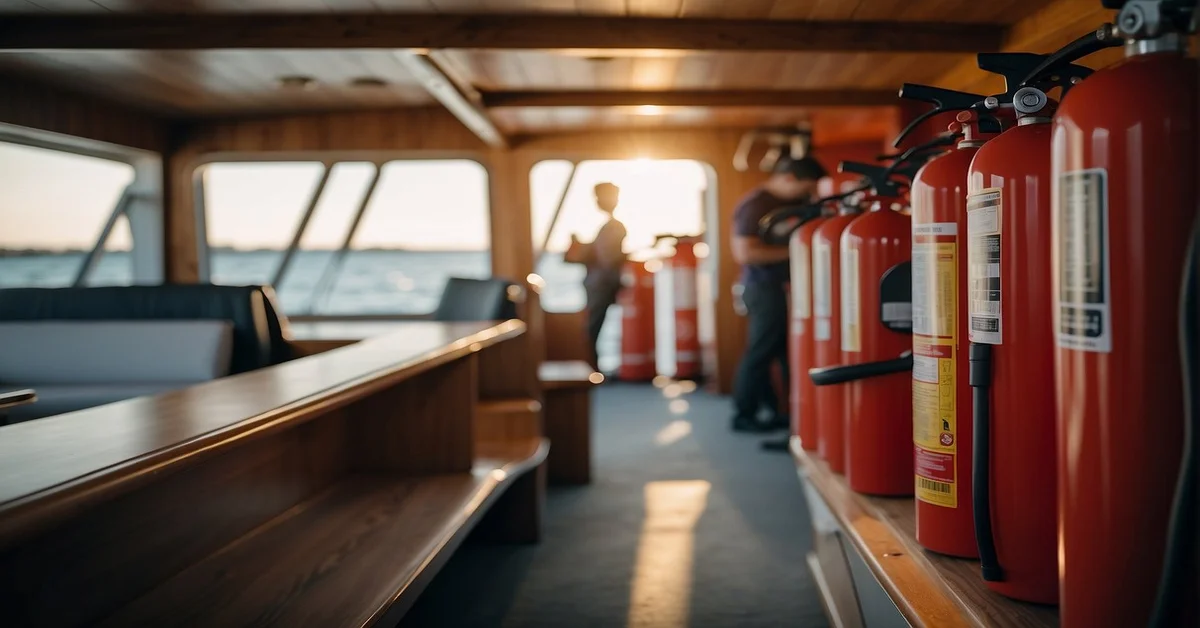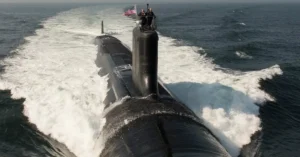Navigating the waters with the right fire extinguisher on board is not just bright – it’s a Coast Guard mandate. Understanding the unique fire risks at sea and equipping your vessel with the appropriate extinguisher is crucial for your safety and compliance.
Get ready to learn the essentials of marine fire safety with this engaging and informative Fire Extinguisher for Boats Guide!
My Top 3 Fire Extinguisher for Boats
When I’m out on the water, ensuring the safety of my crew and vessel is a top priority. A crucial part of that safety is having a reliable fire extinguisher for boats on board. Here, I want to share my top three picks that I trust for keeping my boating adventures safe.
- Kidde Mariner 5 Fire Extinguisher
- Rating: 5-B
- Use: Ideal for small boat fires
- Features: Easy-to-use metal valve, lightweight, non-rechargeable
- Where to Buy: Check them out on Amazon.
- First Alert PRO5 Fire Extinguisher
- Rating: 3-A:40-B
- Use: Suitable for high-capacity marine applications
- Features: Professional-grade rechargeable, with secure mounting bracket
- Where to Buy: Find this model on Boat Outfitters.
- Amerex B417T
- Rating: 1-A:10-B
- Use: Versatile for multiple types of fires
- Features: Rechargeable, with a durable aluminum valve assembly
- Where to Buy: Take a look at Firefighter Garage for details.
Regularly check each extinguisher’s gauge to ensure it’s ready for action whenever needed. Safe boating means being prepared for the unexpected, and a good fire extinguisher can make all the difference.
Selecting the Right Fire Extinguisher for Boats

When it comes to boating safety, having the appropriate fire extinguisher aboard can make all the difference. I think it is a crucial piece of gear that can prevent a small accident from escalating into a dangerous and costly disaster.
Types and Ratings
Selecting the right fire extinguisher for your boat begins with understanding the types of fires you might encounter. Class A fires involve solid combustibles like wood and paper, Class B are flammable liquids like gasoline, and Class C fires involve electrical equipment.
- Dry Chemical Extinguishers: These are versatile and can be used on Class A, B, and C fires. They work by interrupting the chemical reactions that allow fires to continue burning.
- CO2 Extinguishers: These are suitable for Class B and C fires and work by displacing oxygen.
- Foam Extinguishers: They are used primarily for Class A and B fires and suppress flames by cooling the fire and coating the fuel.
Class B and C are most relevant to boat fires, so a B-I or B-II rated fire extinguisher is frequently recommended. A B-I is generally smaller, while a B-II has more extinguishing agent and can handle larger fires.
Size and Capacity
The size and capacity of the fire extinguisher you need depend on your boat’s size. Here’s a quick guide:
- Boats under 26 feet: At least one B-I type fire extinguisher on board.
- Boats 26 to 40 feet: At least two B-I types or one B-II type.
Numbers like 5-B, 10-B, and 20-B refer to the size rating of extinguishers; the higher the number, the greater the capacity to extinguish fires. You may want to consider a 20-B-rated fire extinguisher for extra safety, as it exceeds the USCG minimum requirements.
Boat Specific Requirements
For my boat, I always double-check the specific requirements recommended by boating safety experts and the U.S. Coast Guard. If your vessel is for cargo or carries passengers, you may need a B-II-rated fire extinguisher. This requirement can also depend on whether the boat has an inbuilt fixed extinguishing system in the engine room.
Boat length is a primary determinant of the minimum number of extinguishers needed:
- Under 26 feet: One B-I extinguisher unless there’s a fixed system in the engine room.
- 26-40 feet: Two B-I extinguishers or one B-II.
Always ensure that fire extinguishers are accessible, regularly inspected, and maintained in good working order. Remember, the right fire extinguisher for boats fulfills legal requirements and offers peace of mind that you’re prepared for emergencies.
Maintenance and Inspection

Maintaining a fire extinguisher for boats is crucial to ensure it functions when needed. As a boat owner, I have to check for readiness and compliance with safety standards regularly.
Regular Maintenance
I make it a habit to perform regular maintenance on my fire extinguishers. This involves a few important steps:
- Visual Inspection: Every month, I check my extinguishers for any signs of corrosion or damage. This includes examining the discharge nozzle and hose for blockages or deterioration.
- Pressure Gauge Reading: I ensure the pressure gauge is displaying a green area, indicating the extinguisher is serviceable and ready for use.
- Accessibility: It’s vital that the extinguishers are readily accessible in an emergency, so I always check their designated locations.
Inspection Checklist
Here’s a checklist I follow to make sure nothing is overlooked:
- Pressure Gauge: Confirm it’s within operable range.
- Seals and Tamper Indicators: Check if the lock pin and seals are intact.
- Physical State: Look for corrosion, leaks, or clogs in the nozzle and hose.
- Service Tags: Verify the last professional service date is within the past year.
When to Replace
Knowing when to replace fire extinguishers is key. Here’s how I determine that:
- Date of Manufacture: If it’s over 12 years old, I replace it—even if it seems in good condition.
- After Use or Damage: I replace extinguishers immediately if they’ve been discharged or damaged.
- Failed Inspection: Any failed pressure gauge reading or physical defect means it’s time for a new one.
All my fire extinguishers are USCG approved, meeting the standards set for recreational boats. Remember, portable fire extinguishers can save lives, but only if they’re properly maintained.
FAQ – Fire Extinguisher for Boats

Regarding boating safety, I always emphasize the importance of having a reliable fire extinguisher onboard. It’s a crucial piece of equipment that can prevent a minor incident from becoming a major disaster. Let’s tackle some frequently asked questions about using and maintaining fire extinguisher for boats.
How many fire extinguishers do I need on my boat?
The number depends on your boat’s size.
Boats under 26 feet need at least one B-1 type fire extinguisher.
Boats between 26 to 40 feet require two B-1 type or one B-2 type.
Boats 40 to 65 feet must have three B-1 type or one B-1 plus one B-2 type.
What types of fire extinguishers are recommended for different boat sizes?
How many fire extinguishers do I need on my boat?
The number depends on your boat’s size.
Boats under 26 feet need at least one B-1 type fire extinguisher.
Boats between 26 to 40 feet require two B-1 type or one B-2 type.
Boats 40 to 65 feet must have three B-1 type or one B-1 plus one B-2 type.
Where should I store my fire extinguisher on the boat?
Store your fire extinguisher where it’s easily accessible in case of a fire. The U.S. Coast Guard recommends mounting the extinguisher, but it is not a requirement. Ensure that everyone on board knows where it is. Remember, quick access can be critical.
Set sail in the comments below and share your sea-tested wisdom on choosing the right fire extinguisher for Boats!









